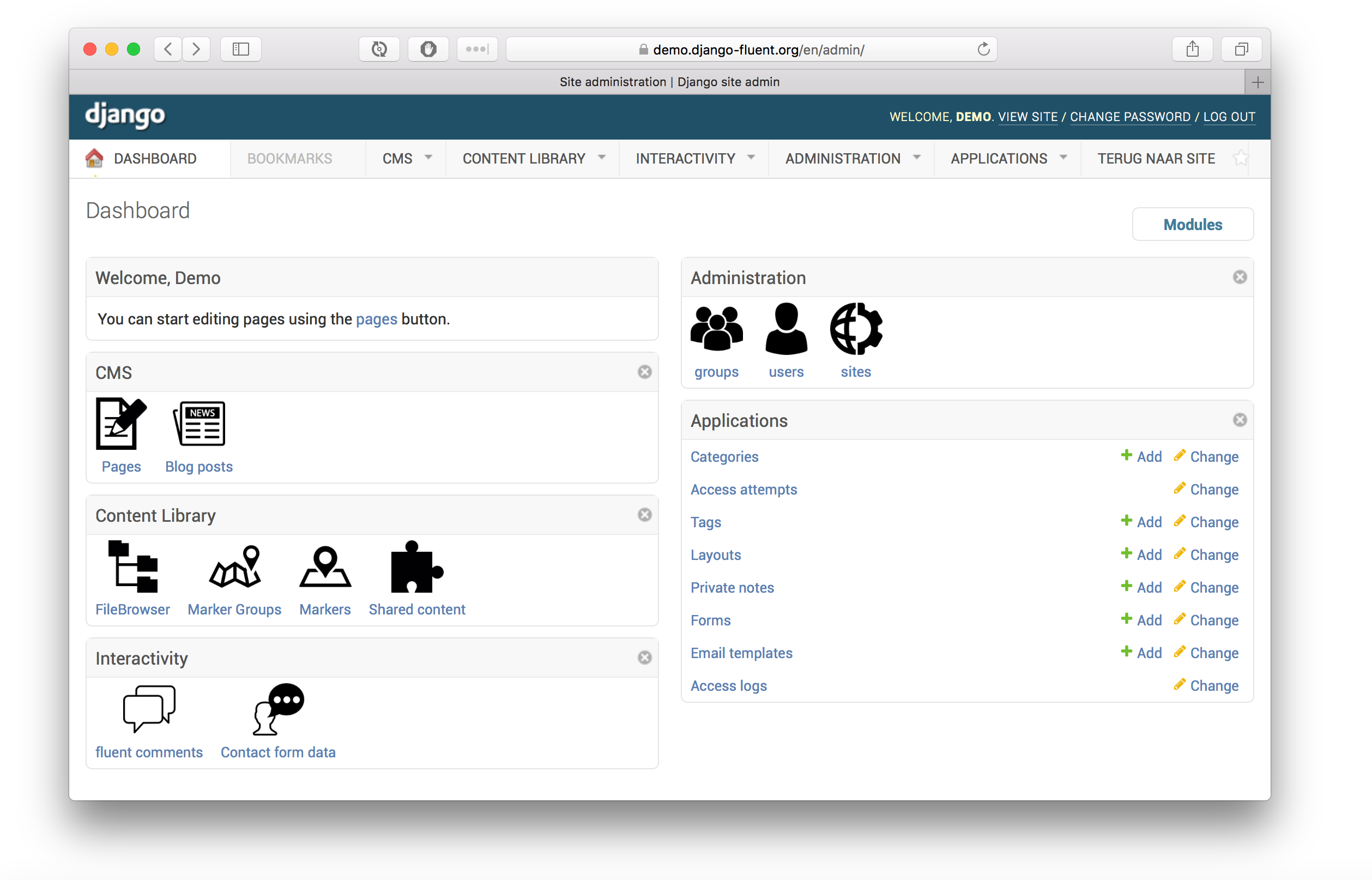An improved django-admin-tools dashboard for Django projects
Project description
django-fluent-dashboard
The fluent_dashboard module offers a custom admin dashboard, built on top of django-admin-tools (docs).
The django-admin-tools package provides a default mechanism to replace the standard Django admin homepage with a widget based dashboard. The fluent_dashboard module extends this, by providing additional widgets (called “modules”) such as:
a “icon list” module for the admin homepage.
a “welcome” module for the admin homepage.
a configurable module layout for the admin homepage, through settings.py.
a “return to site” link.
an optional “cache statistics” module.
Documentation can be found at: http://django-fluent-dashboard.readthedocs.org/
Screenshot

Installation
First install the module, preferably in a virtual environment. It can be installed from PyPI:
pip install django-fluent-dashboard
Or the current folder can be installed:
pip install .
Configuration
Next, create a project which uses the CMS:
cd .. django-admin.py startproject fluentdemo
It should have the following settings:
INSTALLED_APPS += (
'fluent_dashboard',
# enable the admin
'admin_tools',
'admin_tools.theming',
'admin_tools.menu',
'admin_tools.dashboard',
'django.contrib.admin',
)
ADMIN_TOOLS_INDEX_DASHBOARD = 'fluent_dashboard.dashboard.FluentIndexDashboard'
ADMIN_TOOLS_APP_INDEX_DASHBOARD = 'fluent_dashboard.dashboard.FluentAppIndexDashboard'
ADMIN_TOOLS_MENU = 'fluent_dashboard.menu.FluentMenu'
For Django 1.3 the following setting is also required:
ADMIN_MEDIA_PREFIX = '/static/admin/'
Note that some admin_tools applications are optional, yet recommended to have the full experience of the module.
In urls.py:
urlpatterns += patterns('',
url(r'^admintools/', include('admin_tools.urls')),
)
The database tables for admin_tools can be created afterwards:
./manage.py syncdb ./manage.py migrate # If South is installed
Customizing the dashboard
Adding extra icons
The FLUENT_DASHBOARD_APP_ICONS setting is a dictionary that allows you to define extra icons for your own modules, and overwrite default settings. For example:
FLUENT_DASHBOARD_APP_ICONS = {
'auth/user': "user.png"
}
The icon is expected to be 48x48 pixels. The icon name is treated in 3 different formats:
Absolute URLs are passed as-is.
Icon names with a / character, are relative to the STATIC_URL (or MEDIA_URL for Django 1.2).
Icon names without any path information, are relative to the current theme folder, e.g. STATIC_URL/fluent_dashboard/themename/
Organizing the application groups
The FLUENT_DASHBOARD_APP_GROUPS setting defines which applications are grouped. For example:
FLUENT_DASHBOARD_APP_GROUPS = (
(_('CMS'), {
'models': (
'cms.*',
'pages.*',
'fiber.*',
),
'module': 'CmsAppIconList',
'collapsible': False,
}),
(_('Interactivity'), {
'models': (
'django.contrib.comments.*',
'form_designer.*'
'threadedcomments.*',
'zinnia.*',
),
}),
(_('Administration'), {
'models': (
'django.contrib.auth.*',
'django.contrib.sites.*',
'google_analytics.*',
'registration.*',
),
}),
(_('Applications'), {
'models': ('*',),
'module': 'AppList',
'collapsible': True,
}),
)
Details about these options, and additional settings are explained in the documentation.
Displaying cache status
This application features optional support for the dashboardmods package, which can display cache statistics. It can be installed using:
pip install dashboardmods
The application requires the cache backends to be configured, for example:
INSTALLED_APPS += (
'dashboardmods',
)
# Example Memcache configuration:
CACHES = {
'default': {
'BACKEND': 'django.core.cache.backends.memcached.MemcachedCache',
'KEY_PREFIX': 'mysite.production',
'LOCATION': '127.0.0.1:11211',
'TIMEOUT': 24*3600,
},
}
# Optional, example Varnish configuration:
VARNISH_MANAGEMENT_ADDRS = ('127.0.0.1:6082',)
When a cache is not configured, it will simply not be displayed by the module.
Contributing
This module is designed to be generic. In case there is anything you didn’t like about it, or think it’s not flexible enough, please let us know. We’d love to improve it!
If you have any other valuable contribution, suggestion or idea, please let us know as well because we will look into it. Pull requests are welcome too. :-)
Project details
Release history Release notifications | RSS feed
Download files
Download the file for your platform. If you're not sure which to choose, learn more about installing packages.
Source Distribution
File details
Details for the file django-fluent-dashboard-0.3.2.tar.gz.
File metadata
- Download URL: django-fluent-dashboard-0.3.2.tar.gz
- Upload date:
- Size: 246.8 kB
- Tags: Source
- Uploaded using Trusted Publishing? No
File hashes
| Algorithm | Hash digest | |
|---|---|---|
| SHA256 | 48516685f3ef62a79e9b5782ab891bf3ee6dfa97453bd34e5a679b90d8446965 |
|
| MD5 | 0db4e26c9edd376747c065b2030ba544 |
|
| BLAKE2b-256 | 239a7ce73e694ede9a2bc2e74713205c6ceb95c12004b733e4df049e9484e082 |











